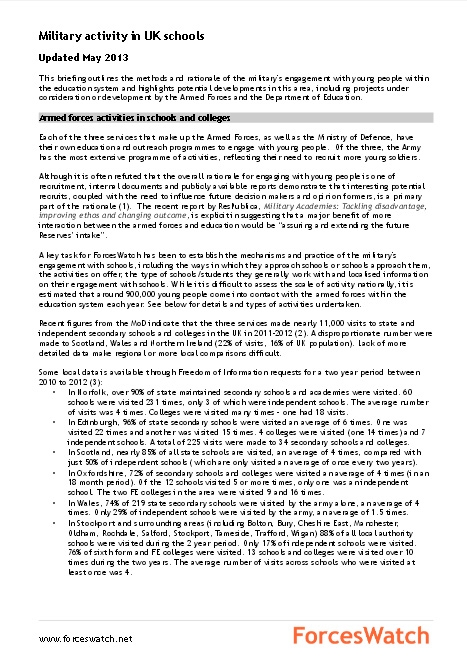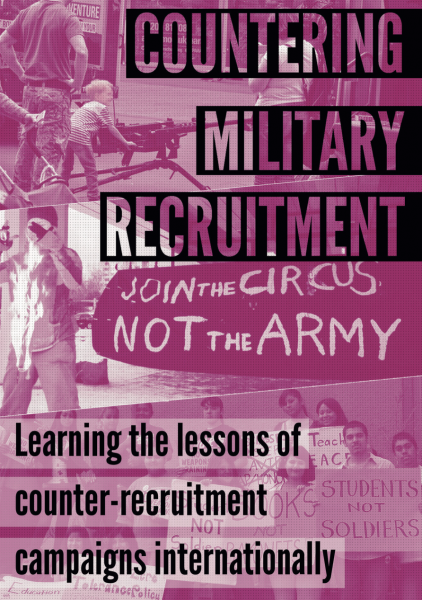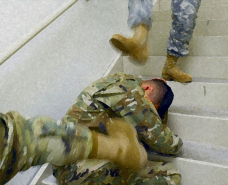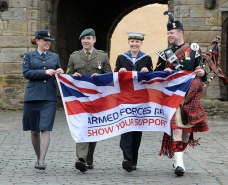Military activity in UK schools: report

Forces Watch - Updated May 2013
This briefing outlines the methods and rationale of the military's engagement with young people within the education system and highlights potential developments in this area, including projects under consideration or development by the Armed Forces and the Department of Education.
Armed forces activities in schools and colleges
Each of the three services that make up the Armed Forces, as well as the Ministry of Defence, have their own education and outreach programmes to engage with young people. Of the three, the Army has the most extensive programme of activities, reflecting their need to recruit more young soldiers.
Although it is often refuted that the overall rationale for engaging with young people is one of recruitment, internal documents and publicly available reports demonstrate that interesting potential recruits, coupled with the need to influence future decision makers and opinion formers, is a primary part of the rationale (1). The recent report by ResPublica, Military Academies: Tackling disadvantage, improving ethos and changing outcome, is explicit in suggesting that a major benefit of more interaction between the armed forces and education would be “ assuring and extending the future Reserves’ intake” .
A key task for ForcesWatch has been to establish the mechanisms and practice of the military's engagement with schools, including the ways in which they approach schools or schools approach them, the activities on offer, the type of schools/students they generally work with and localised information on their engagement with schools. While it is difficult to assess the scale of activity nationally, it is estimated that around 900,000 young people come into contact with the armed forces within the education system each year. See below for details and types of activities undertaken.
Recent figures from the MoD indicate that the three services made nearly 11,000 visits to state and independent secondary schools and colleges in the UK in 2011-2012 (2). A disproportionate number were made to Scotland, Wales and Northern Ireland (22% of visits, 16% of UK population). Lack of more detailed data make regional or more local comparisons difficult.
Some local data is available through Freedom of Information requests for a two year period between 2010 to 2012 (3):
-
In Norfolk , over 90% of state maintained secondary schools and academies were visited. 60 schools were visited 231 times, only 3 of which were independent schools. The average number of visits was 4 times. Colleges were visited many times – one had 18 visits.
-
In Edinburgh , 96% of state secondary schools were visited an average of 6 times. One was visited 22 times and another was visited 15 times. 4 colleges were visited (one 14 times) and 7 independent schools. A total of 225 visits were made to 34 secondary schools and colleges.
-
In Scotland , nearly 85% of all state schools are visited, an average of 4 times, compared with just 50% of independent schools (which are only visited an average of once every two years).
-
In Oxfordshire , 72% of se condary schools and colleges were visited an average of 4 times (in an 18 month period). Of the 12 schools visited 5 or more times, only one was an independent school. The two FE colleges in the area were visited 9 and 16 times.
-
In Wales , 74% of 219 state secondary schools were visited by the army alone, an average of 4 times. Only 29% of independent schools were visited by the army, an average of 1.5 times.
- In Stockport and surrounding areas (including Bolton, Bury, Cheshire East, Manchester, Oldham, Rochdale, Salford, Stockport, Tameside, Trafford, Wigan) 88% of al l local authority schools were visited during the 2 year period. Only 17% of independent schools were visited. 76% of sixth form and FE colleges were visited. 13 schools and colleges were visited over 10 times during the two years. The average number of visits across schools who were visited at least once was 4.
Pushing a 'military ethos'
In addition to the current challenges facing those concerned with this issue, there are greater challenges yet to come. In the past six months there has been an increase in visible efforts to integrate the military into national education policy. The Department for Education's “military skills and ethos programme encompasses Cadets, Troops to Teachers, the cadet version of the National Citizen Service and alternative provision with a military ethos.” (FOI request, 13/07/12). On Armed Forces Day 2012, the Government announced a budget of nearly £11m to expand cadet units into state schools.
'Alternative provision' includes the Military to Mentors programme run by Skillforce and a £1m grant for work from September 2012 “supporting military ethos in schools”, working with “pupils who are either disengaged with education or at risk of becoming disengaged ....utilising the skills of a high proportion of former armed services personnel or other staff with experience in this field of work”.
The Department for Education states that “these programmes will give young people the opportunity to develop teamwork, self-discipline, resilience and leadership” but do not explain what is meant by 'military ethos' or why a military framework will develop these skills more effectively than one based in other 'service' contexts. Furthermore, that there may be aspects of a 'military ethos' that are not appropriate to education does not seem to have been considered.
Military Academies / Service Schools
Following the ResPublica report calling for the establishment of Military Academies, a number of politicians (from Labour and the Conservative Party) have supported the idea of 'service schools', which would be primarily or entirely staffed by ex-servicemen and women. The rationale would be to provide ex-forces with employment opportunities, introduce a more disciplinarian ethos to schools in need of it and increase recruitment capacity (especially to the reserve forces). The politicians interested in this scheme speak almost exclusively about the second of these recommendations in what seems to be very much a reaction to the riots in summer 2011.
Summary of activities across the UK:
There are no national figures that provide a reliable overview of the number of young people that take part in armed forces related activity within education. However, youth/schools engagement surveys conducted by the MoD suggest that, at a minimum, around 900,000 children (mainly 8-19 years old) are contacted each year, which is about 15% of the age group.
Army
-
Presentations – These can cover various topics such as the role of the Army as well as topics such as peacekeeping and presentations on Afghanistan.
-
Insight Interviews – The Army run Insight Courses which are designed to offer a taste of what life is like in the Army. The interviews with students who want to attend a course provide information on the course and what is expected of them so they get the most from the course. • Careers Fair – The Army having a stand at a school fair with other businesses.
-
Careers Day – A whole day in the school to discuss Army Careers. • Careers Brief – A single presentation on Careers in the Army (could be recorded as a presentation).
-
Team Visits – Support of the National Curriculum • Schools Challenge – This is a regionally run competition between schools run by the Army Careers Adviser pitting the schools against each other in a competition based around command tasks (such as getting across an area using ropes and planks etc.).
-
Visits to bases and army museums
-
Mock interviews
-
Work experience
-
Other challenge activities
-
Sessions with staff
- Higher education bursary promotion and interviews
In addition, a large number of curriculum resources are provided on the Army in Education website.
Navy
Schools received a wide variety of activities, including:
- Careers Conventions/Jobs Fairs
- Shows & Exhibitions & Carnival (or Parade)
- Presentations about the work of the Royal Navy and Royal Marines • Displays by the Royal Marine Commando Team
- Team-Building exercises • Physical Training and sports instruction (including a programme called Fit 4 Life)
- Careers presentations • Alternative curriculum events such as 'leadership tasks'
RAF
All visits prior to the most recent academic year were made by the RAF Presentation Team which no longer visits schools.
Quotation from letter sent to ForcesWatch regarding RAF visits to schools:
All schools received the same 40 minute presentation, a series of narrative and DVD presentations that cover who the RAF are, what they do and how they do it. The ‘who we are’ section covers a few facts and figures about the trades within the RAF. The ‘what we do’ section focuses on the four pillars of air power (Intelligence & Situational Awareness, Control of the Air, Attack and Air Mobility & Lift). The ‘how we do it’ section covers training, specialist roles and welfare. There is Q&A session at the end.
Visits to schools include:
-
Presentations on the RAF
-
Careers events and exhibitions
-
Staff briefings
-
Various challenge activities
-
Personal development training
- Visits to bases • Mock interviews Notes
1. On the reasons to provide armed forces related activities within education: • The MoD have stated that curricular activities are “a powerful way to facilitate recruitment”. MoD Strategy for Delivery of MOD Youth Initiatives. Directorate of Reserve Forces and Cadets, 2005 • “Our overall rationale for engaging with schools is to encourage good citizenship, provide an environment which raises awareness of the MOD and Armed Forces among young people, provide positive information to influence future opinion formers, and to enable recruiters to access the school environments.” Engagement with UK schools, MoD, 2007
2. See Hansard for 15 April 2013: http://www.publications.parliament.uk/pa/cm201213/cmhansrd/cm130415/text... 30415w0003.htm_wqn10 3.
All data obtained by ForcesWatch under the Freedom of Information Act is available on the whatdotheyknow.org website. Data for army visits to Wales was obtained separately and is not in the public domain.
Source: http://www.forceswatch.net
###
Countering Military Recruitment

WRI's new booklet, Countering Military Recruitment: Learning the lessons of counter-recruitment campaigns internationally, is out now. The booklet includes examples of campaigning against youth militarisation across different countries with the contribution of grassroot activists.
You can order a paperback version here.








